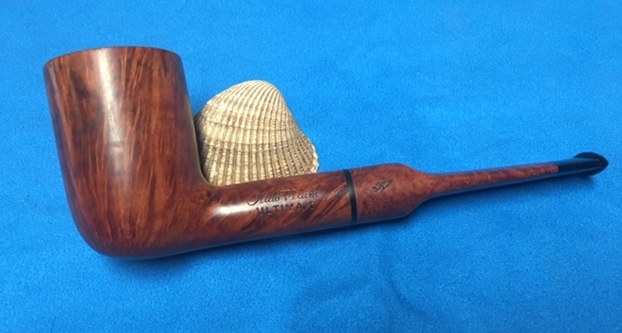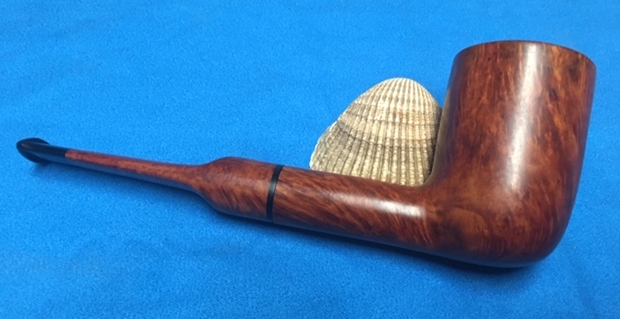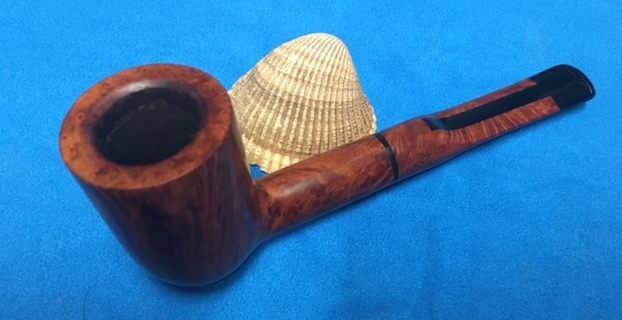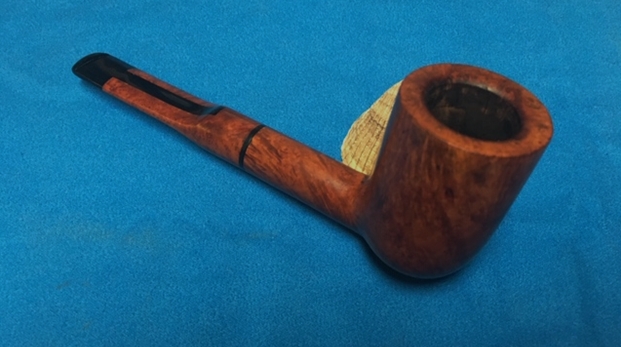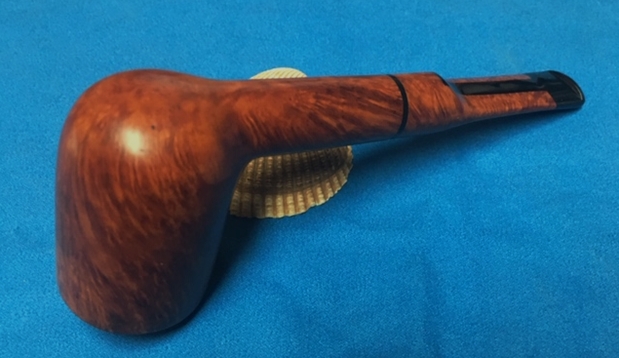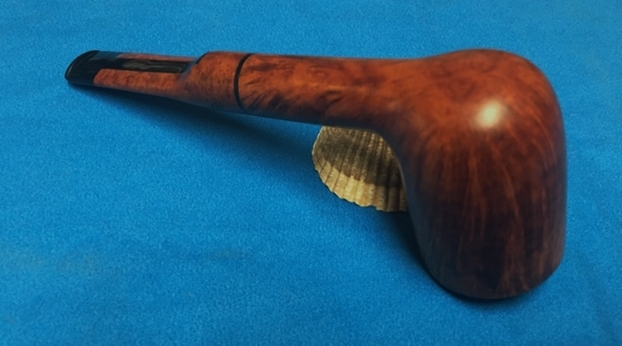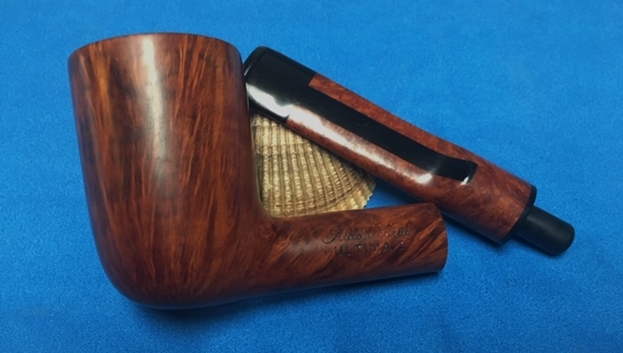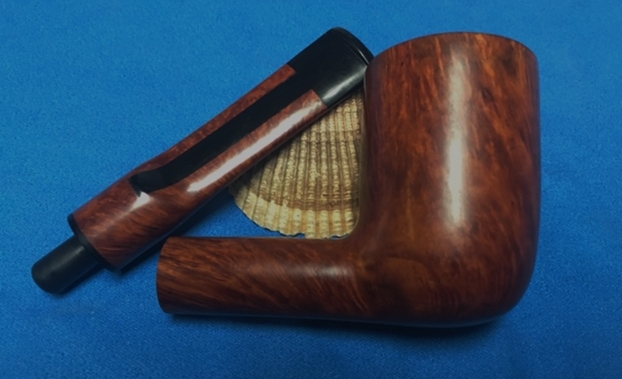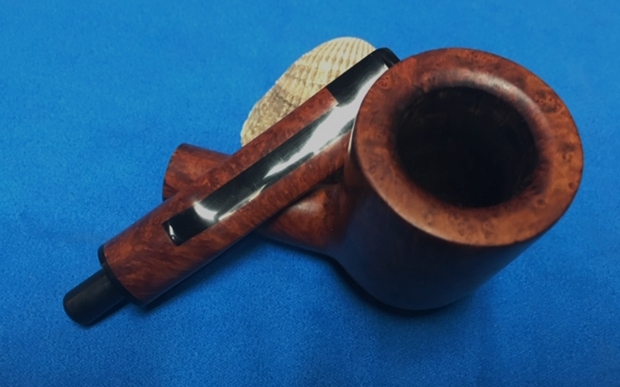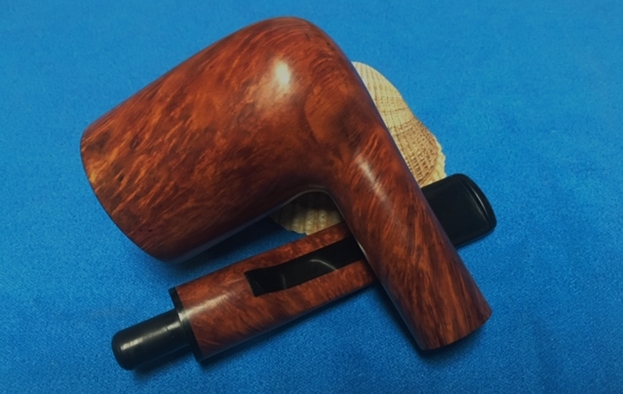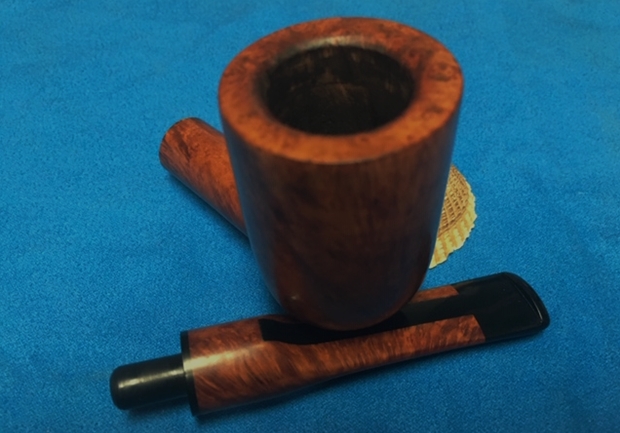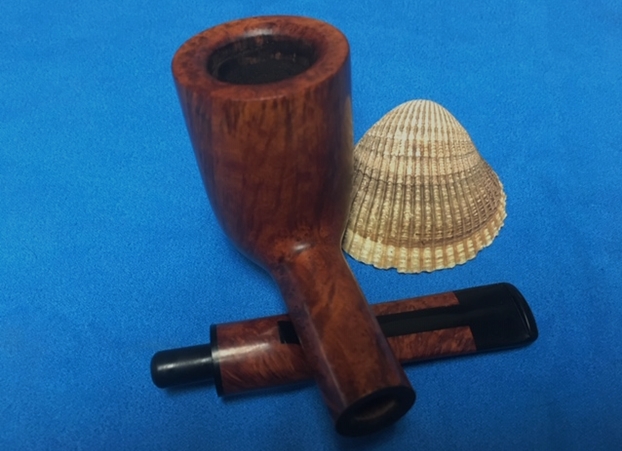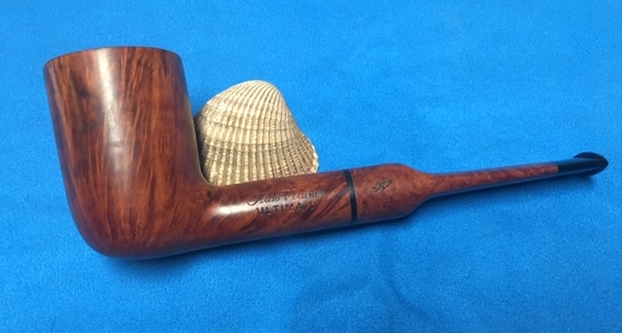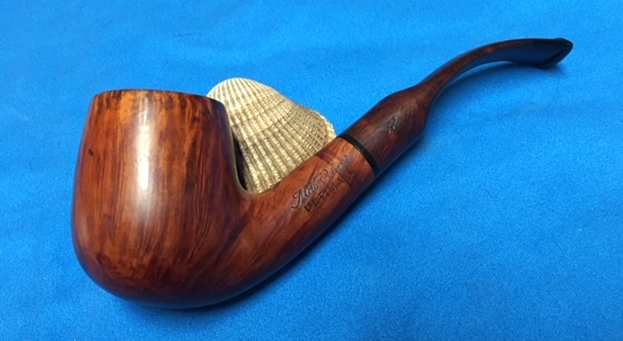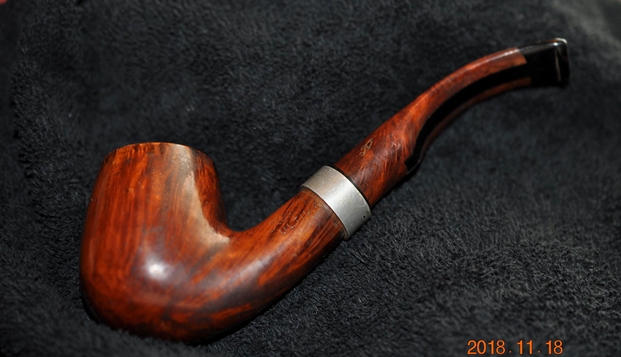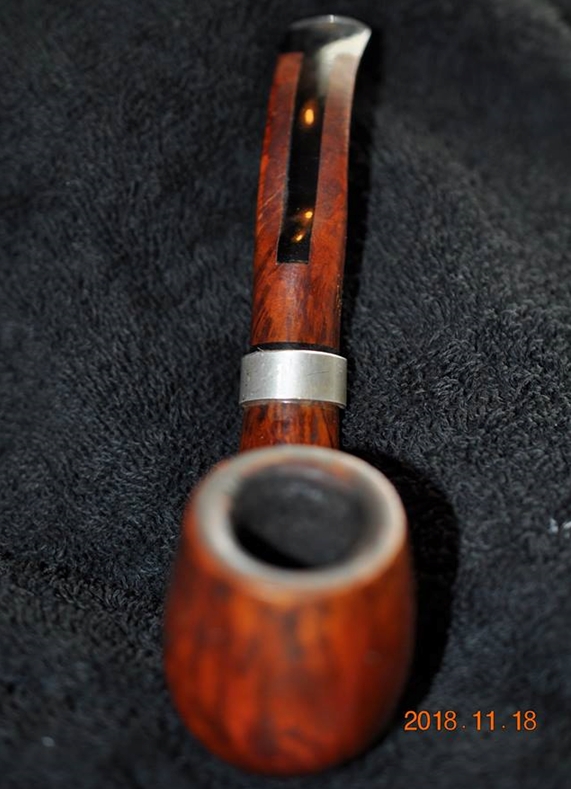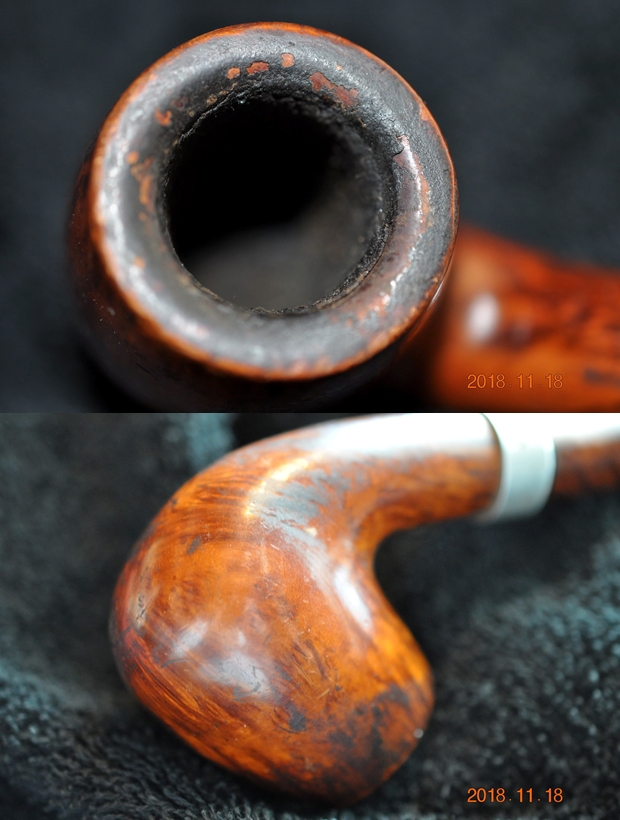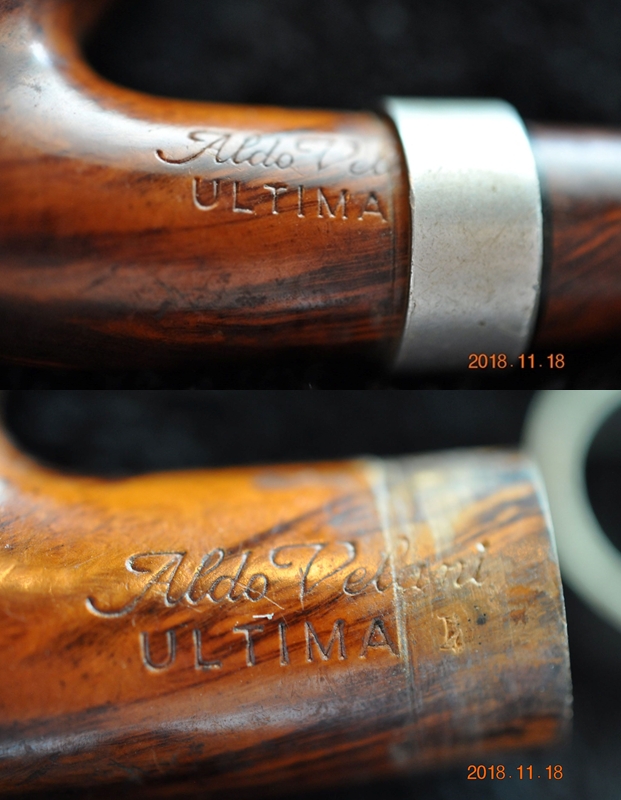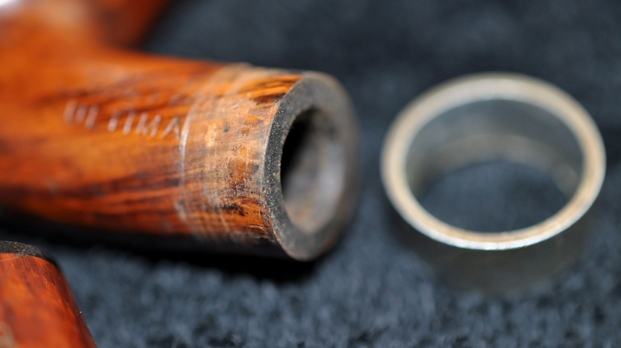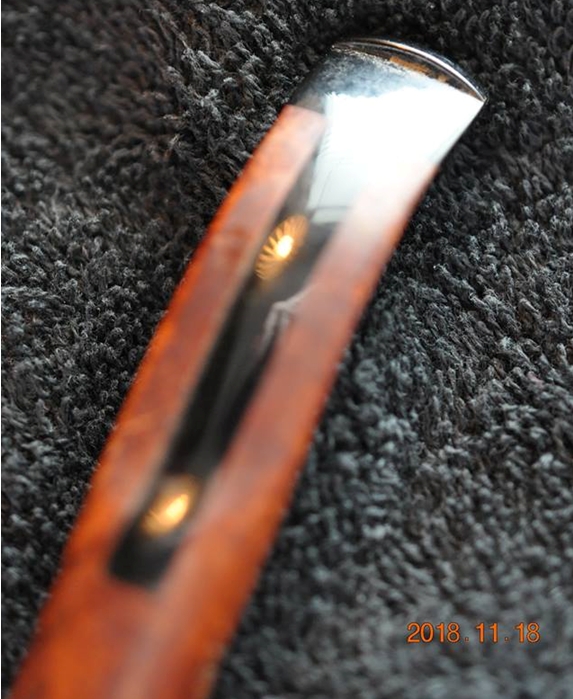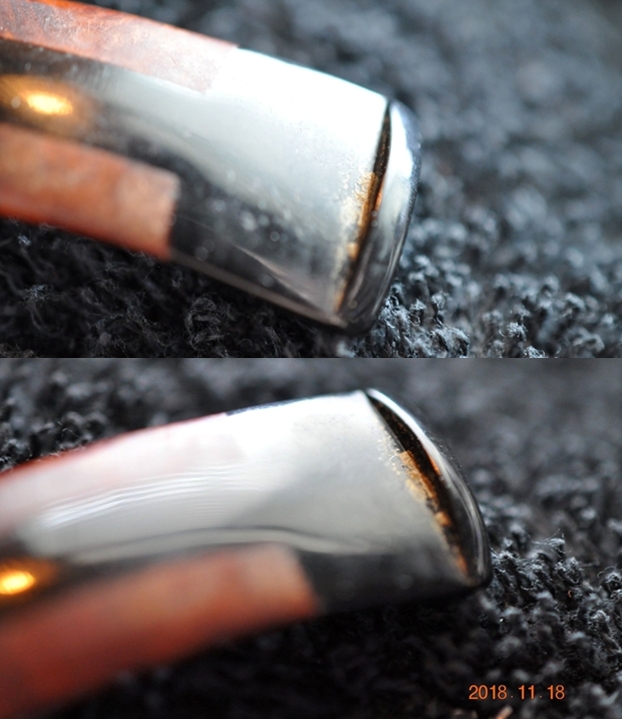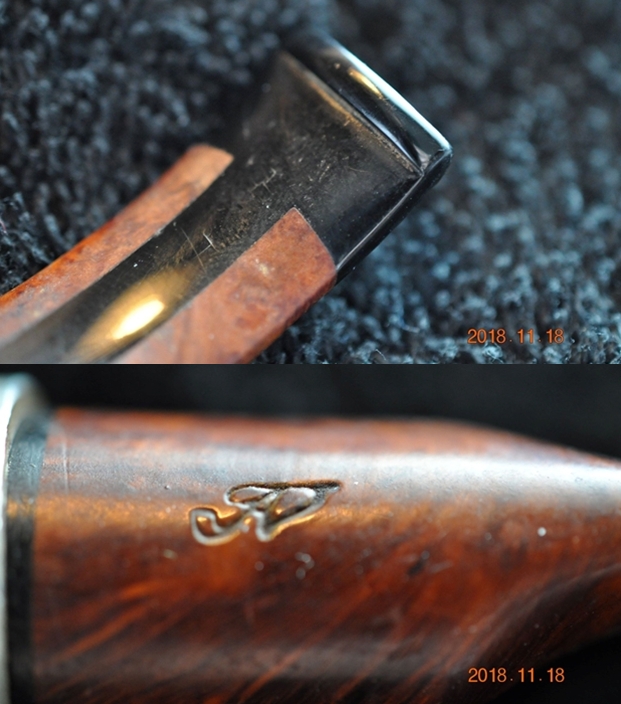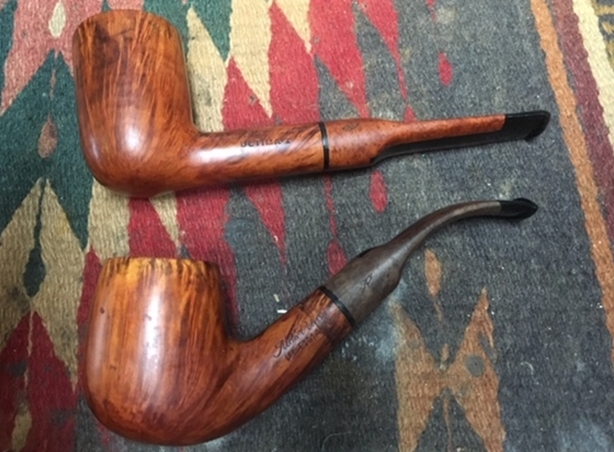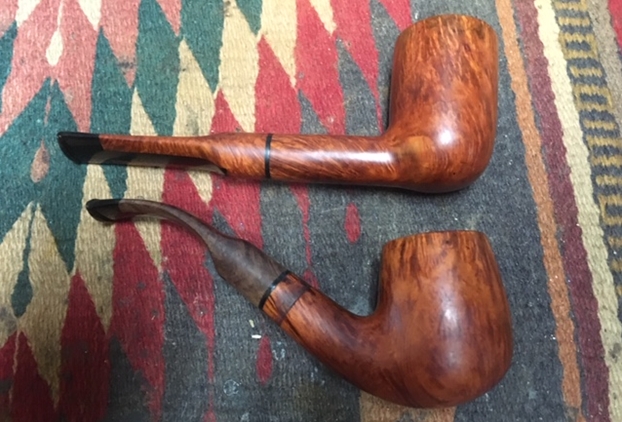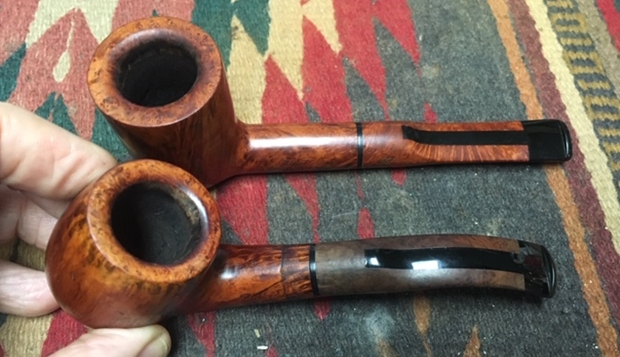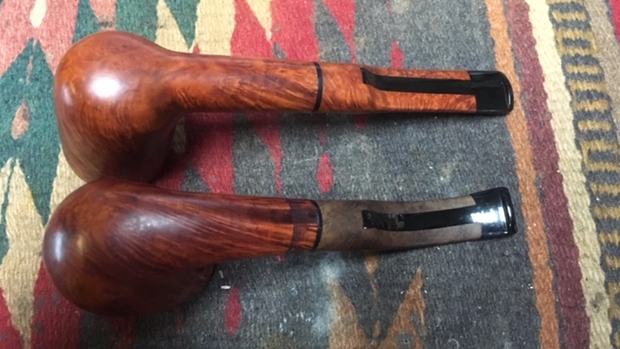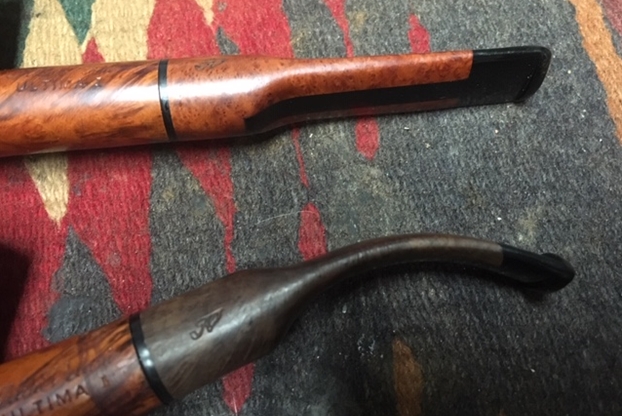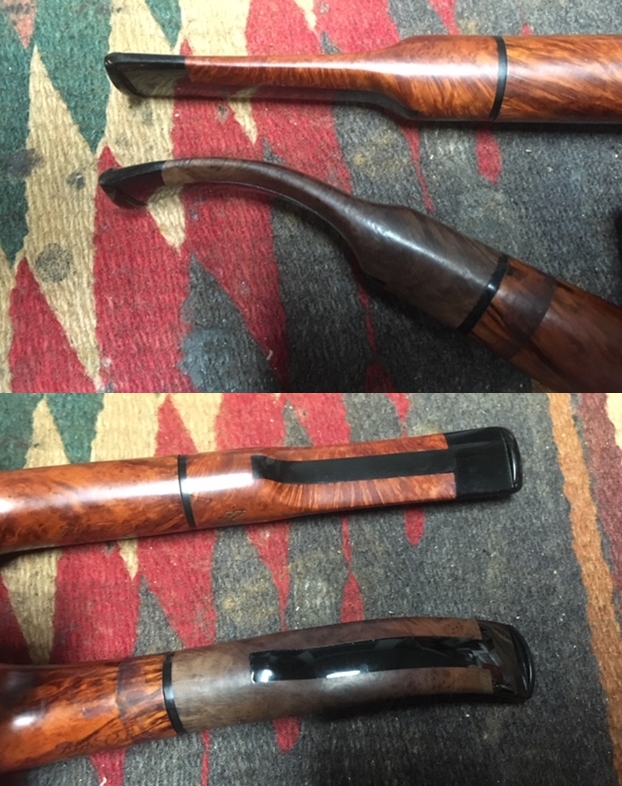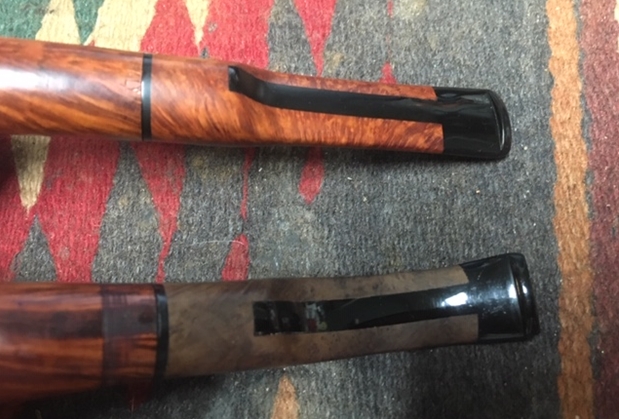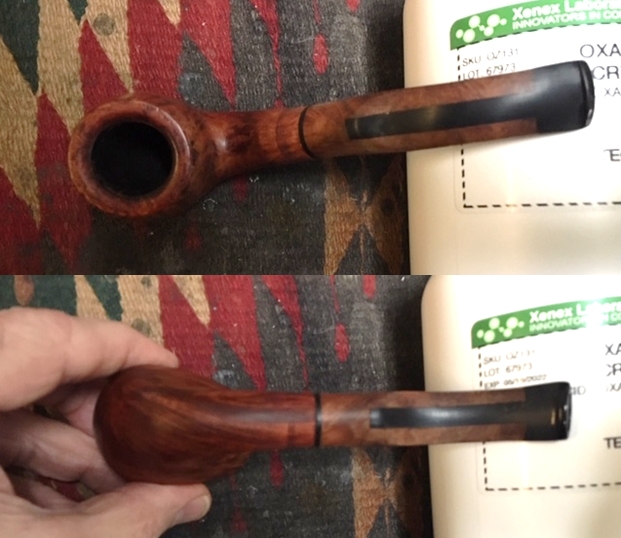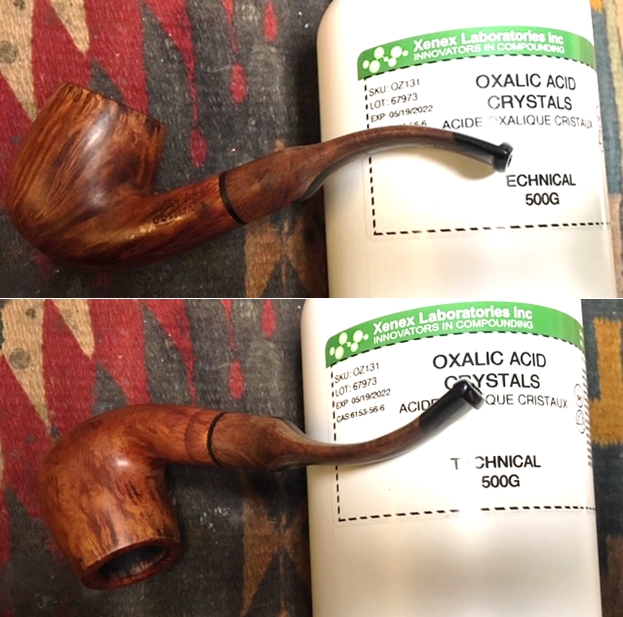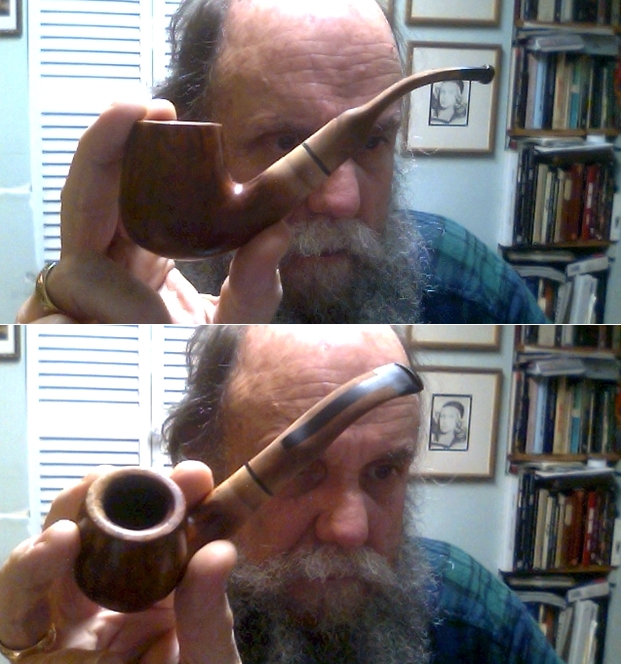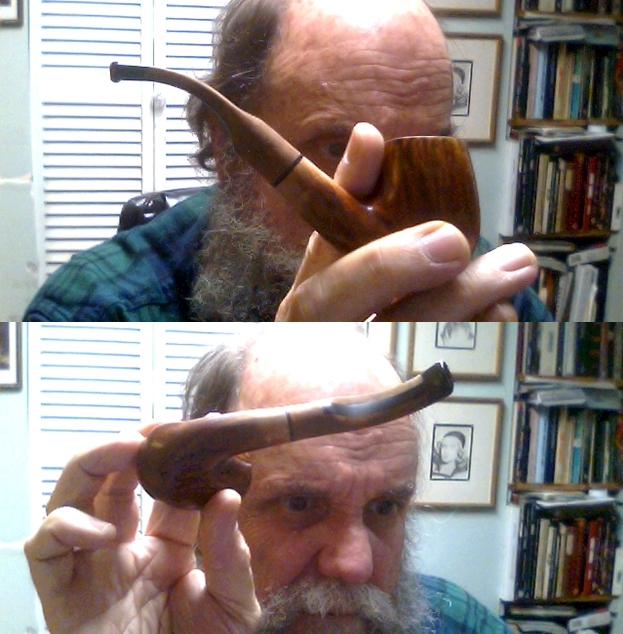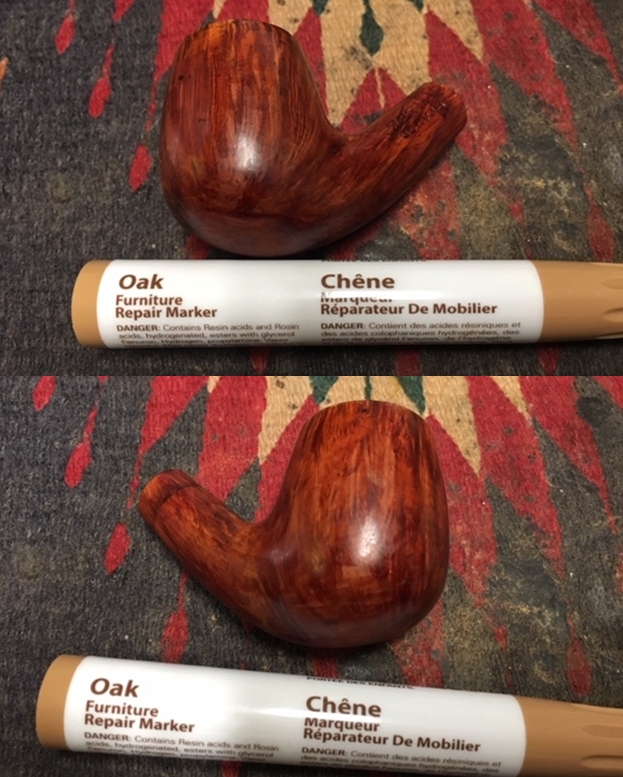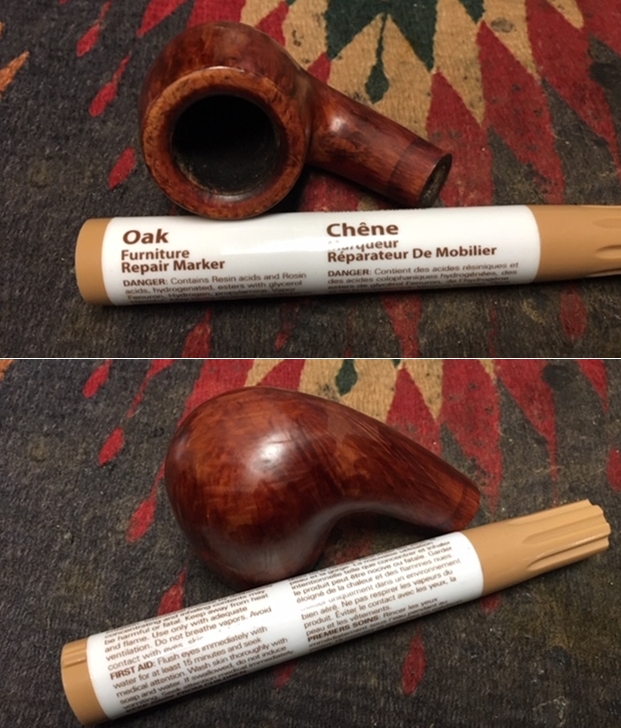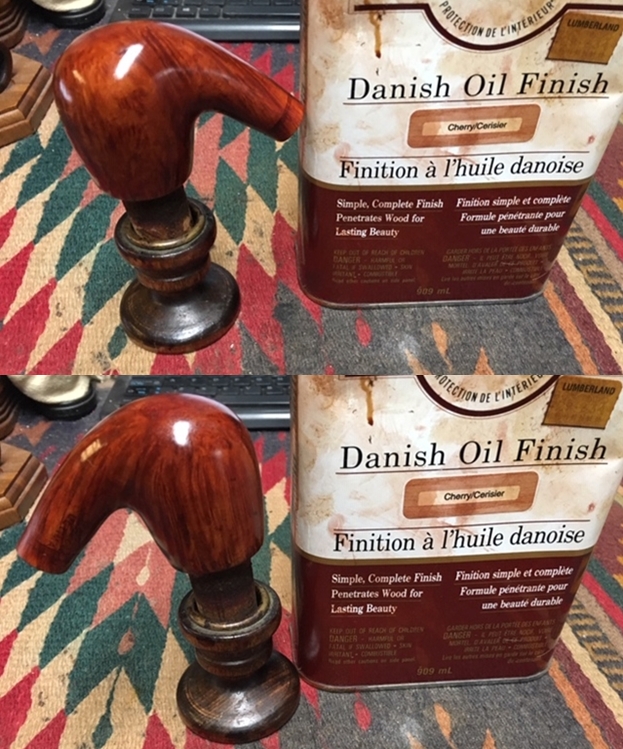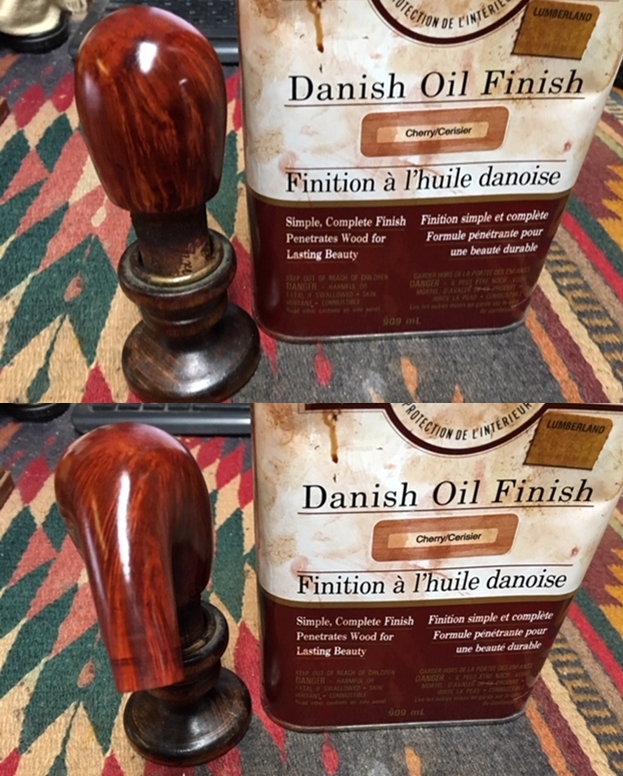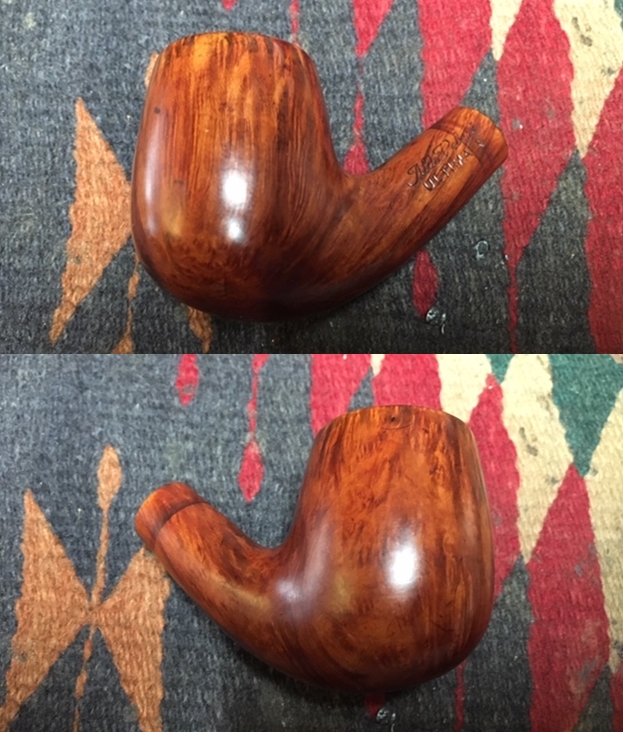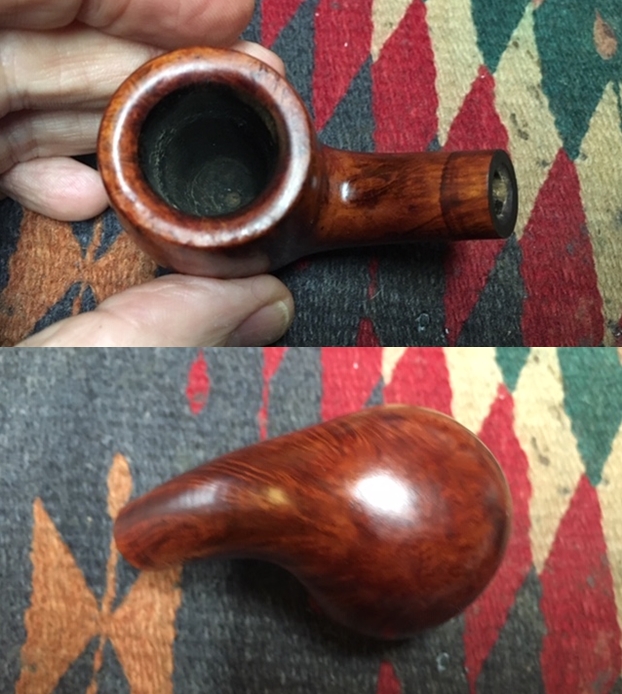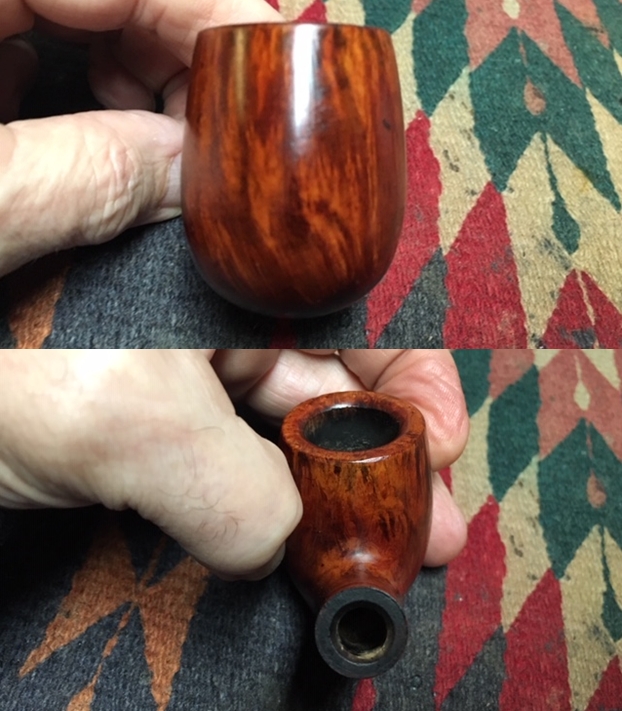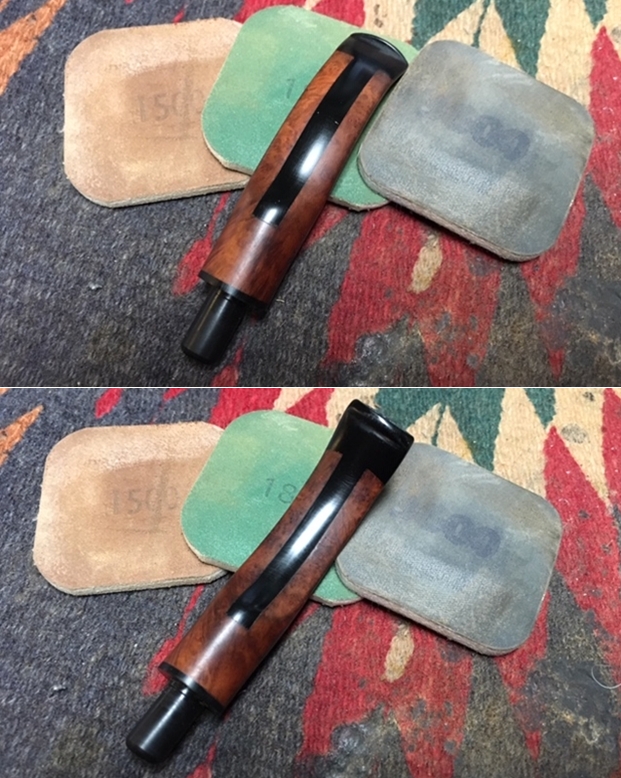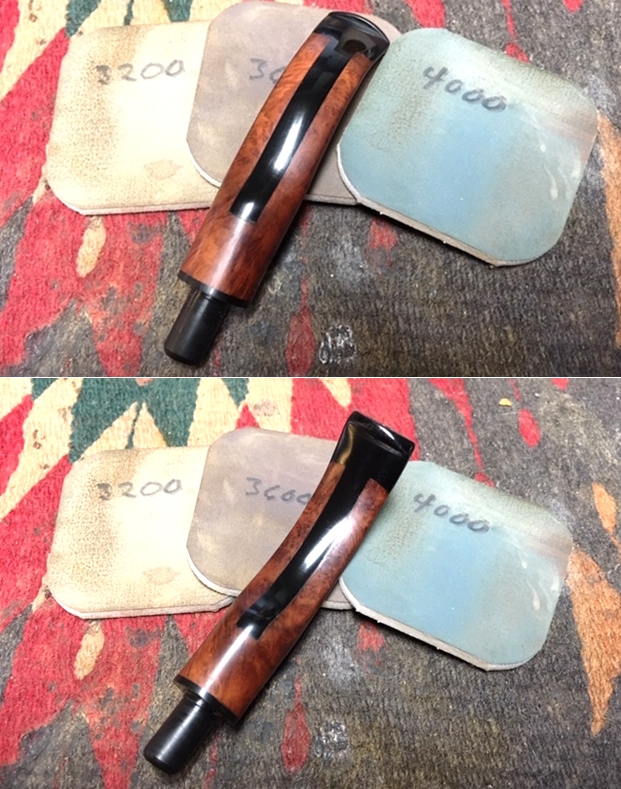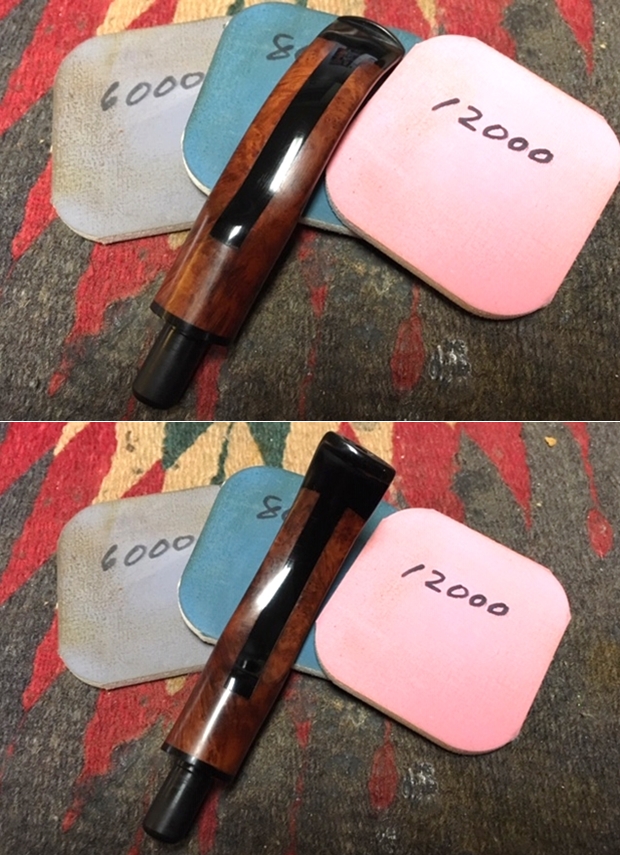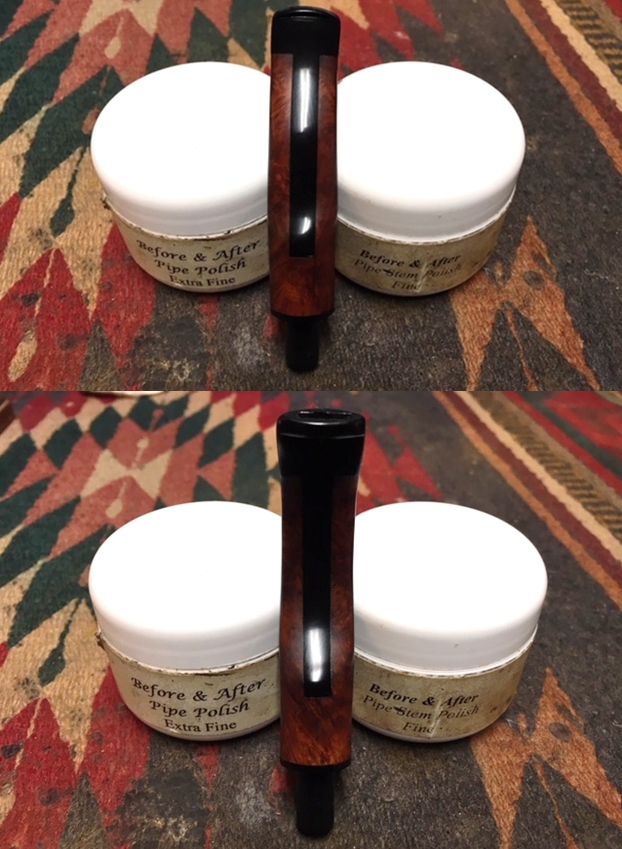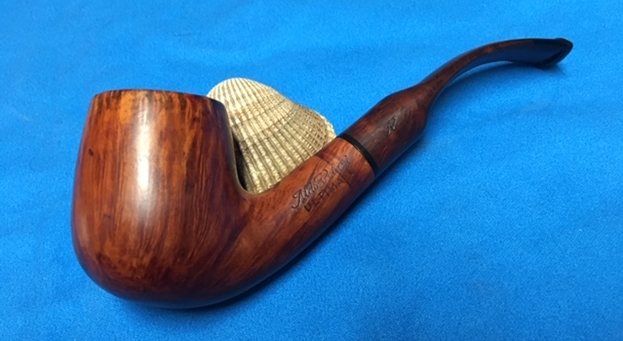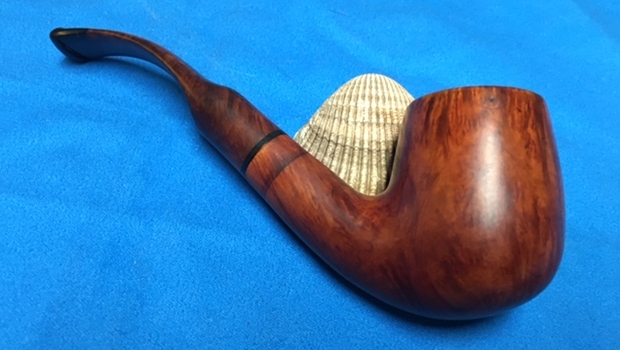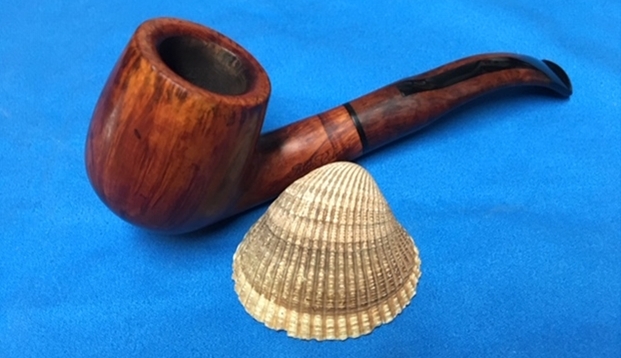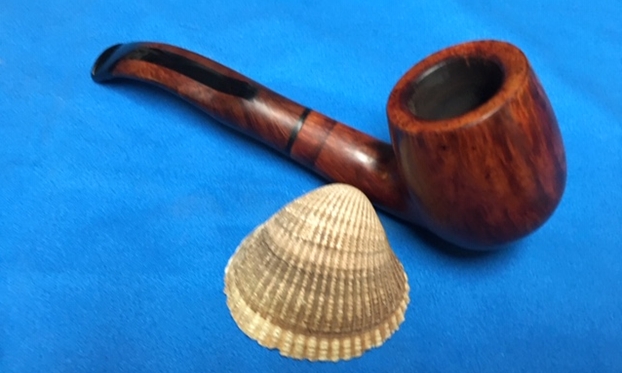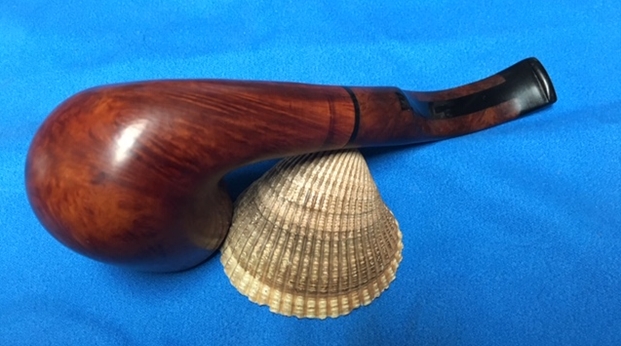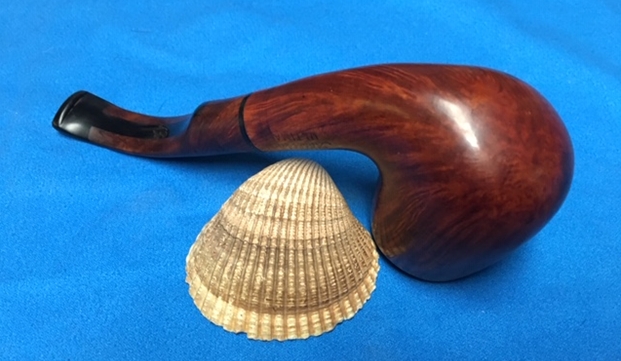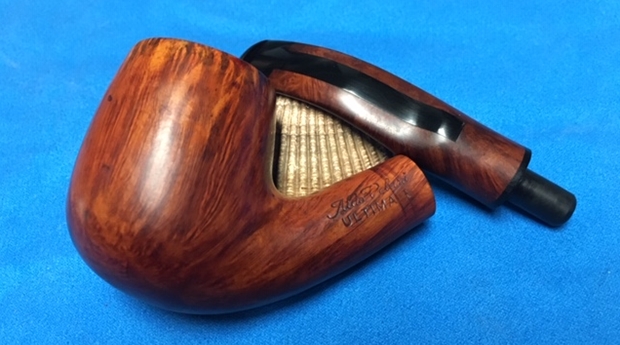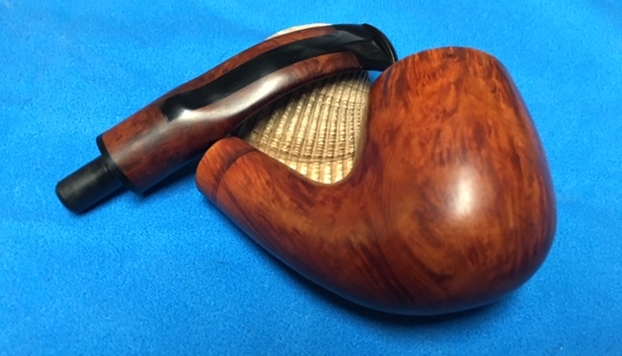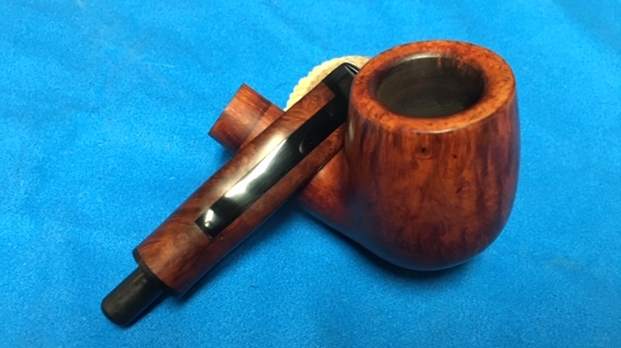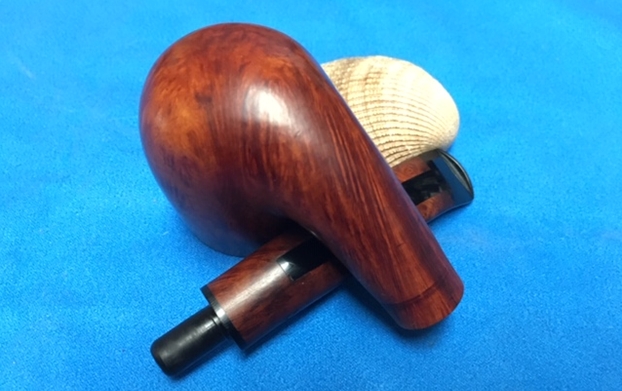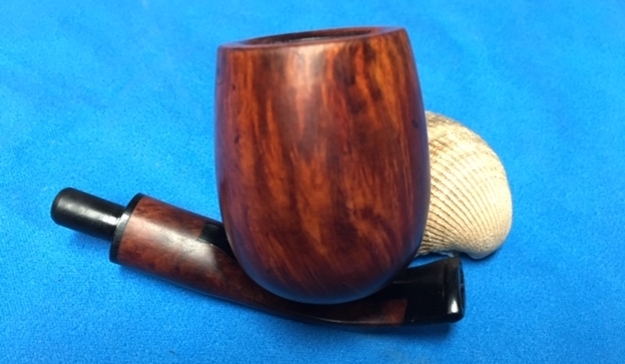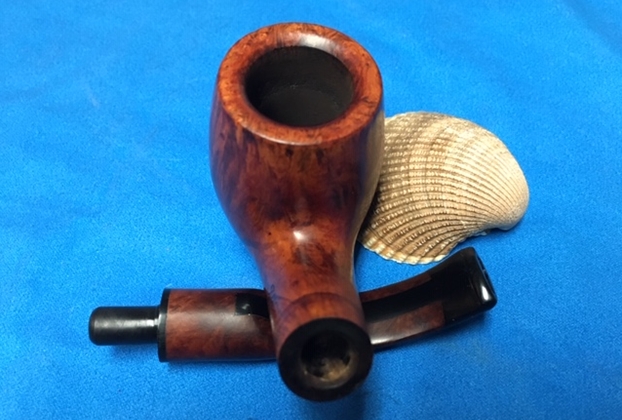Blog by Steve Laug
My brother Jeff picked up a pair of Aldo Velani Ultima 1 pipes in a lot he purchased on an auction. The Ultima 1 has a composite stem with briar inserts on the saddle and along the sides of the stem with Lucite forming the base of the stem. There are strips of Lucite on the top and underside and in the bite area around the button. It really is a beautiful looking pipe with a lot of class and distinction. Most Aldo Velani pipes are made in Livorno, Italy, for the USA market by Cesare Barontini. They were previously imported by Lane Limited. The name “Aldo Velani” is actually fictional and the brand was made for export (https://pipedia.org/wiki/Aldo_Velani http://www.pipephil.eu/logos/en/logo-a3.html). The second pipe of the pair was in significantly better condition than the first one. The pipes were probably made in the 1990s. This one was dirty but the exterior was in better shape. There was a thick cake in the bowl and there was a lava overflow on the rim top. This one was as it was made – no band added and no changes to the pipe. The stem was dirty and had light tooth marks on the Lucite around the button. Jeff took photos of the pipe before he started his clean up. 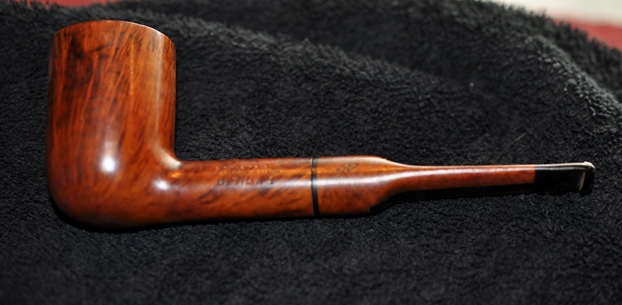
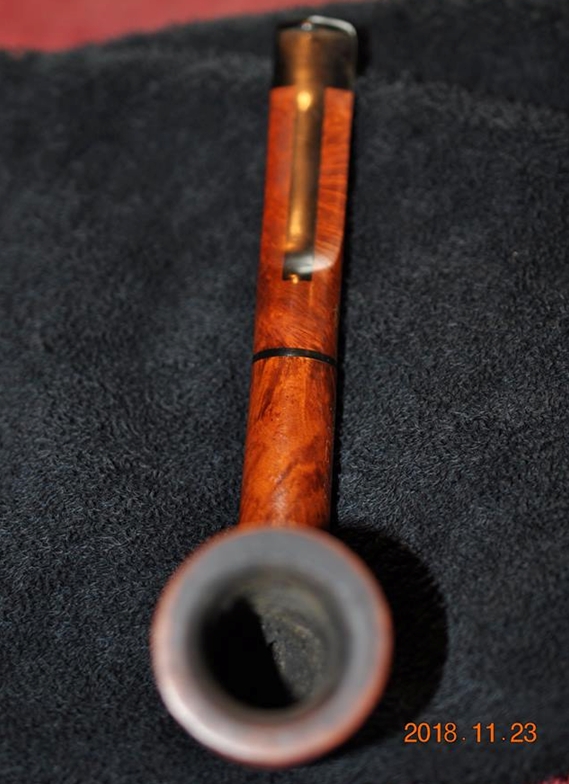 He took some photos of the rim top and the side of the bowl to show how dirty it was. You can see the lava on the rim and the cake in the bowl. You can also see the sticky buildup on the exterior of the bowl.
He took some photos of the rim top and the side of the bowl to show how dirty it was. You can see the lava on the rim and the cake in the bowl. You can also see the sticky buildup on the exterior of the bowl.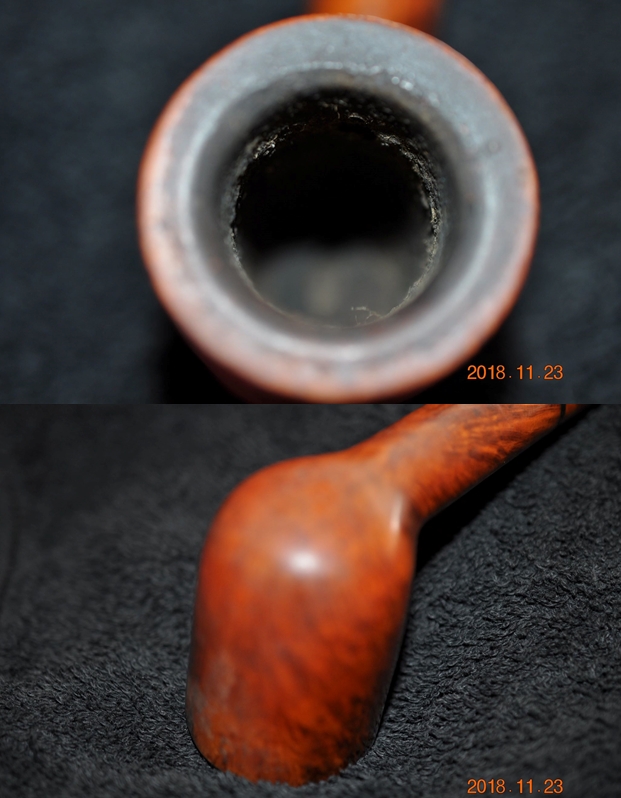 He took photos of the stamping on the shank – it read Aldo Velani over Ultima 1. On the underside of the shank it is stamped ITALY next to the shank/stem union. There was a nice acrylic band on the stem between the briar of the shank and the briar on the stem. The stem showed some wear and tear but it was in much better condition than its brother. The left side of the saddle stem also had the AV stamp in the briar. It always amazes me how dirty some folks let their pipes get. This one has a sticky substance all over the stem surfaces and a build up of gunk on the button and along its edges.
He took photos of the stamping on the shank – it read Aldo Velani over Ultima 1. On the underside of the shank it is stamped ITALY next to the shank/stem union. There was a nice acrylic band on the stem between the briar of the shank and the briar on the stem. The stem showed some wear and tear but it was in much better condition than its brother. The left side of the saddle stem also had the AV stamp in the briar. It always amazes me how dirty some folks let their pipes get. This one has a sticky substance all over the stem surfaces and a build up of gunk on the button and along its edges.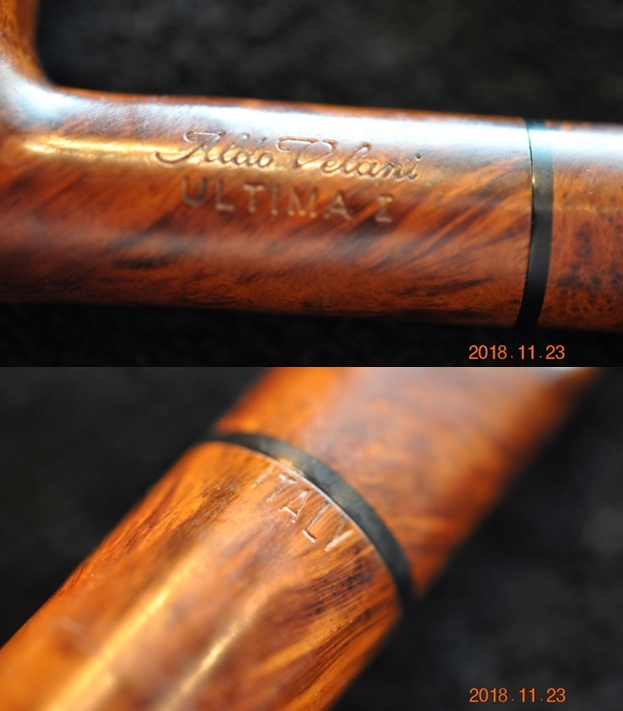
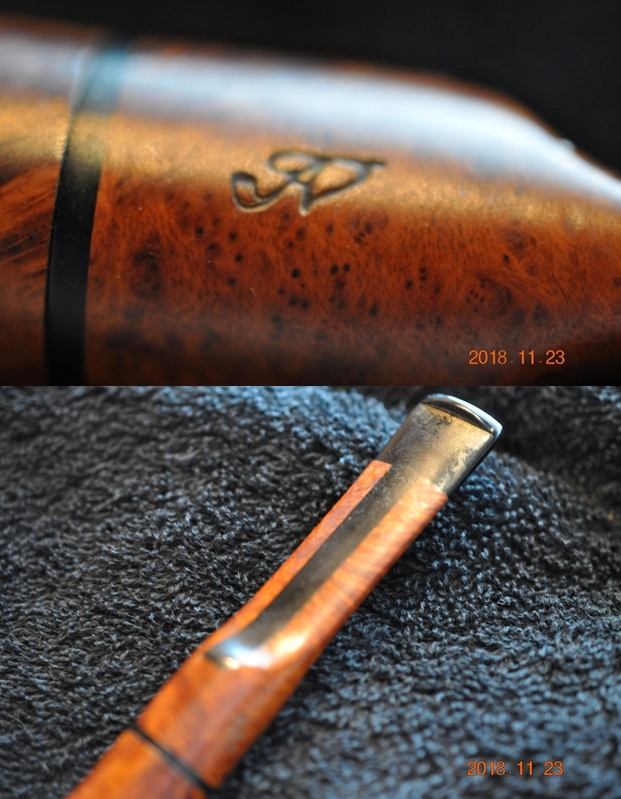
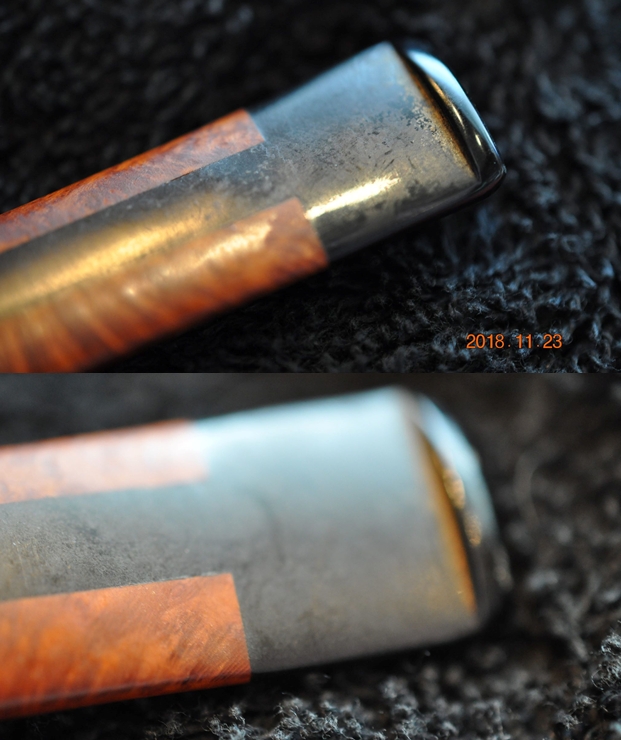 Jeff cleaned the pipe with his usual thoroughness – reaming the bowl and scrubbing the internals with alcohol, cotton swabs and pipe cleaners. He scrubbed the exterior with Murphy’s Oil Soap to clean off the dust and grime on the finish. The rim top looked very good and the bowl itself looked great. The stem was in great shape other than a bit of tooth chatter. He cleaned the inside of the airways with alcohol and pipe cleaners. He did not put this one in the Before & After Deoxidizer Bath having seen the effects on the other one. I took photos of the pipe when it arrived here.
Jeff cleaned the pipe with his usual thoroughness – reaming the bowl and scrubbing the internals with alcohol, cotton swabs and pipe cleaners. He scrubbed the exterior with Murphy’s Oil Soap to clean off the dust and grime on the finish. The rim top looked very good and the bowl itself looked great. The stem was in great shape other than a bit of tooth chatter. He cleaned the inside of the airways with alcohol and pipe cleaners. He did not put this one in the Before & After Deoxidizer Bath having seen the effects on the other one. I took photos of the pipe when it arrived here. 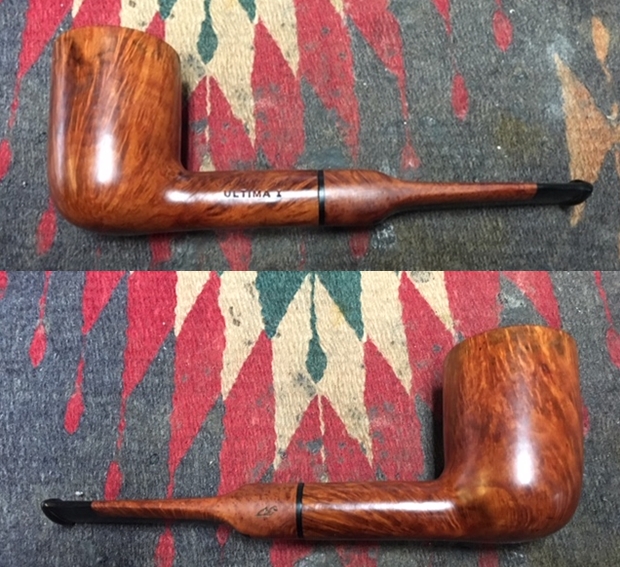
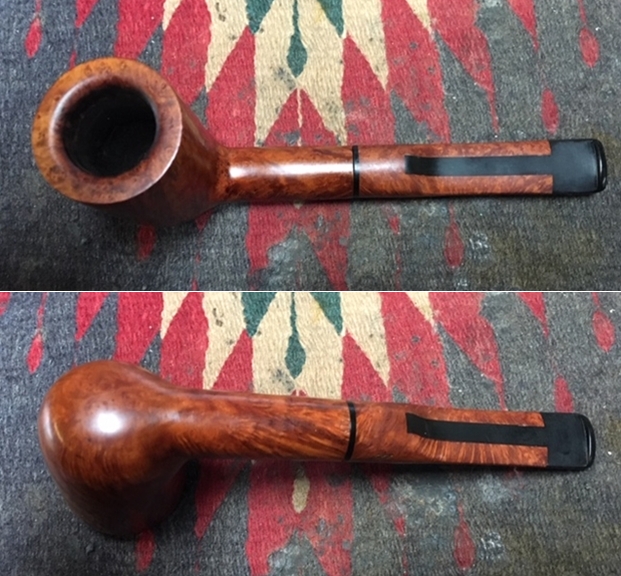 I polished the bowl and shank with 1500-12000 grit micromesh sanding pads. I wet sanded it with 1500-2400 and dry sanded it with 3200-12000 grit pads. I wiped it down after each pad with a damp cloth to remove the sanding dust. The photos below show the progress in the polishing.
I polished the bowl and shank with 1500-12000 grit micromesh sanding pads. I wet sanded it with 1500-2400 and dry sanded it with 3200-12000 grit pads. I wiped it down after each pad with a damp cloth to remove the sanding dust. The photos below show the progress in the polishing.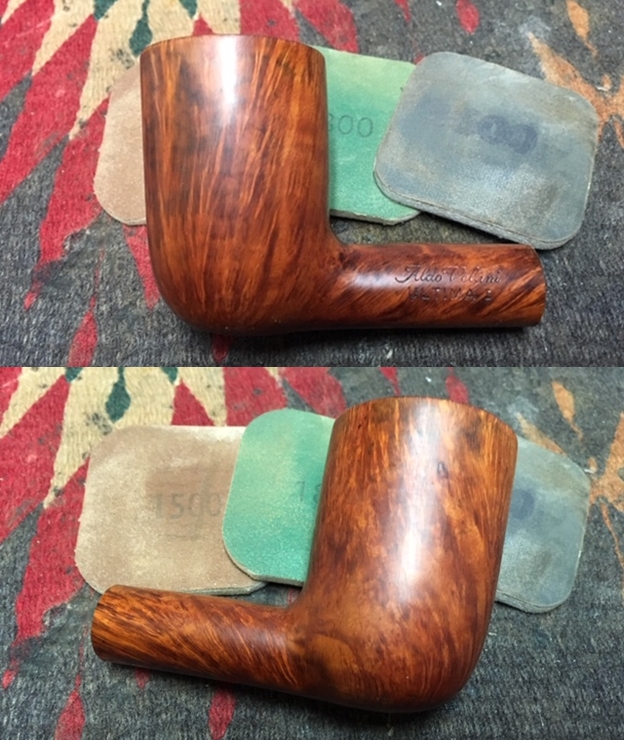
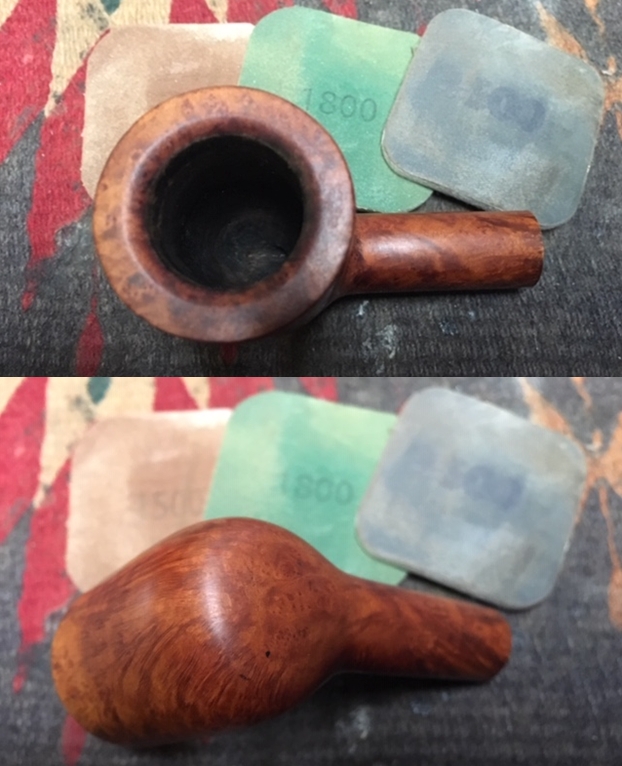
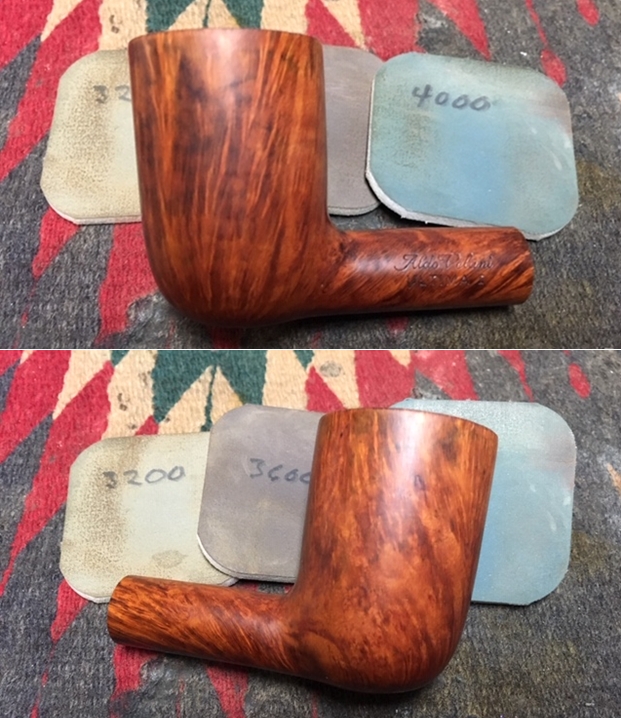
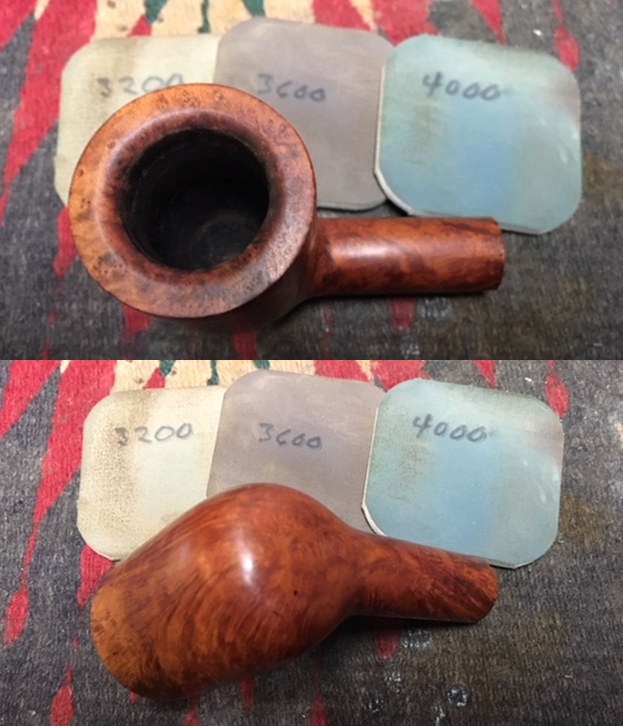
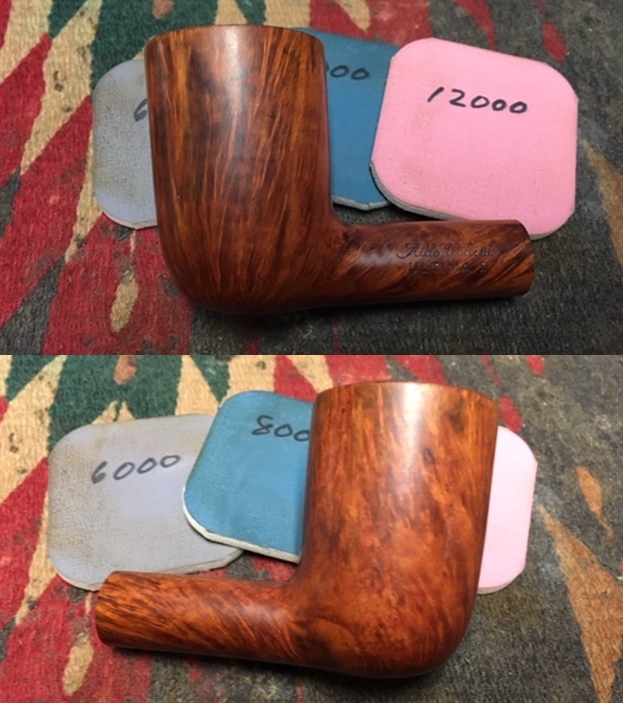
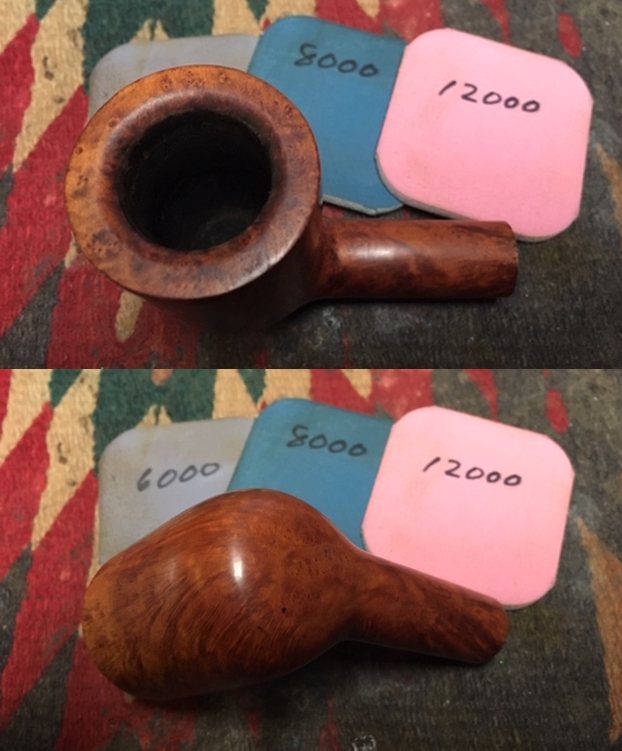 The pipe was beginning to look really good and the grain was beginning to really pop. It was time to work some Before & After Restoration Balm into the briar on the bowl and the rim top. I worked it into the surface with my fingertips to clean, enliven and protect the wood. I let the balm sit for about 20 minutes and buffed it off with a soft cotton cloth. I took photos of the pipe at this point in the process to show what the bowl looked like at this point.
The pipe was beginning to look really good and the grain was beginning to really pop. It was time to work some Before & After Restoration Balm into the briar on the bowl and the rim top. I worked it into the surface with my fingertips to clean, enliven and protect the wood. I let the balm sit for about 20 minutes and buffed it off with a soft cotton cloth. I took photos of the pipe at this point in the process to show what the bowl looked like at this point.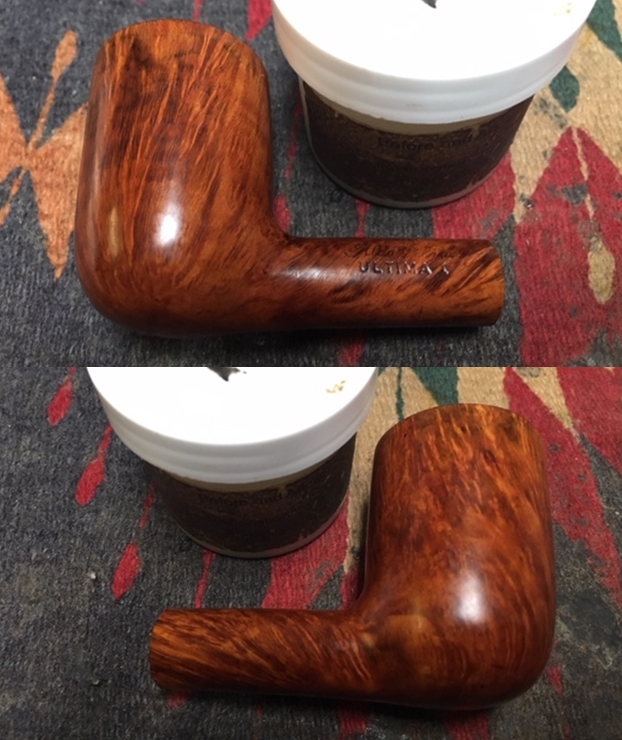
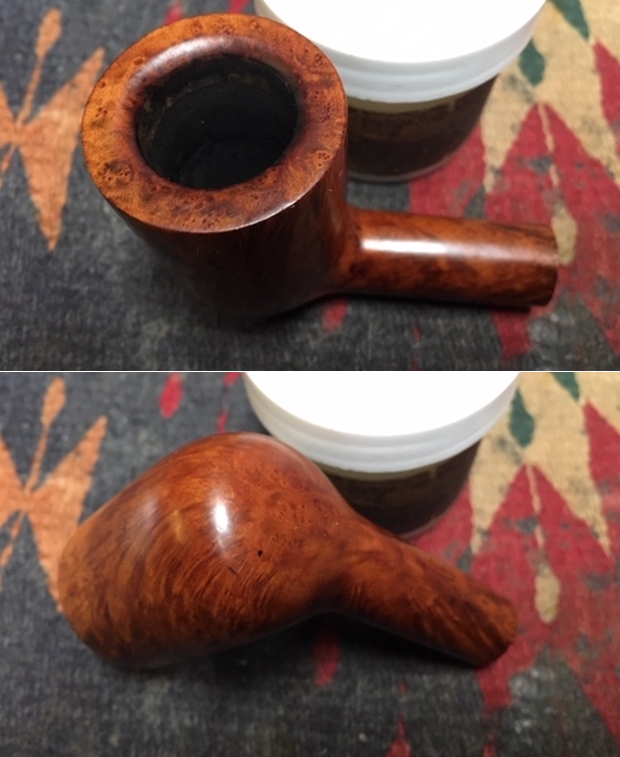
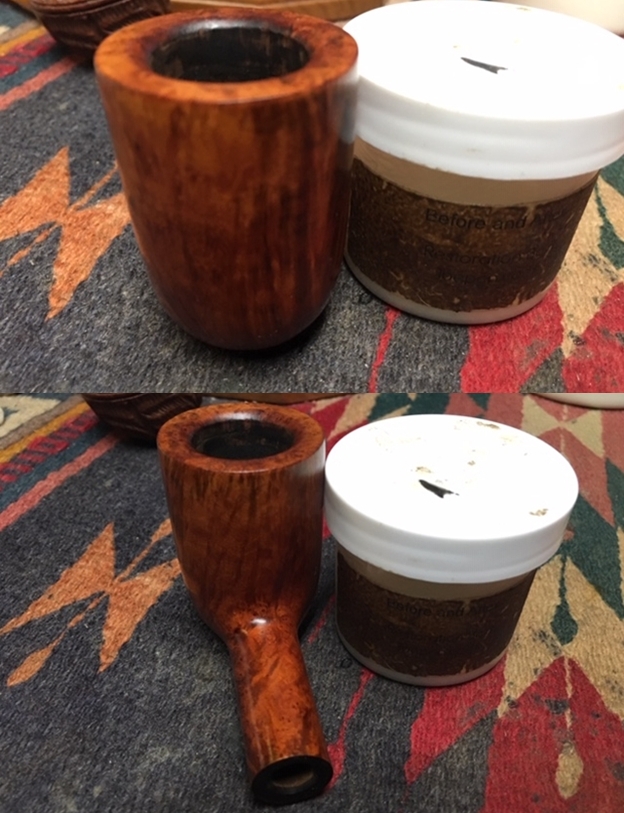 I set the bowl aside at this point and turned my attention to the stem. I was really glad to see that this composite briar and Lucite stem was in decent condition. There was some light tooth chatter and scratching but nothing serious. It would only need to be polished. I polished it with micromesh sanding pads to remove the scratching left behind by the 220 grit sandpaper and give the briar and the Lucite a shine. I wet sanded with 1500-2400 grit pads and dry sanded with 3200-12000 grit pads. I wiped the stem down with a damp cloth after each pad. When I was finished the stem looked great. The photos tell the story.
I set the bowl aside at this point and turned my attention to the stem. I was really glad to see that this composite briar and Lucite stem was in decent condition. There was some light tooth chatter and scratching but nothing serious. It would only need to be polished. I polished it with micromesh sanding pads to remove the scratching left behind by the 220 grit sandpaper and give the briar and the Lucite a shine. I wet sanded with 1500-2400 grit pads and dry sanded with 3200-12000 grit pads. I wiped the stem down with a damp cloth after each pad. When I was finished the stem looked great. The photos tell the story. 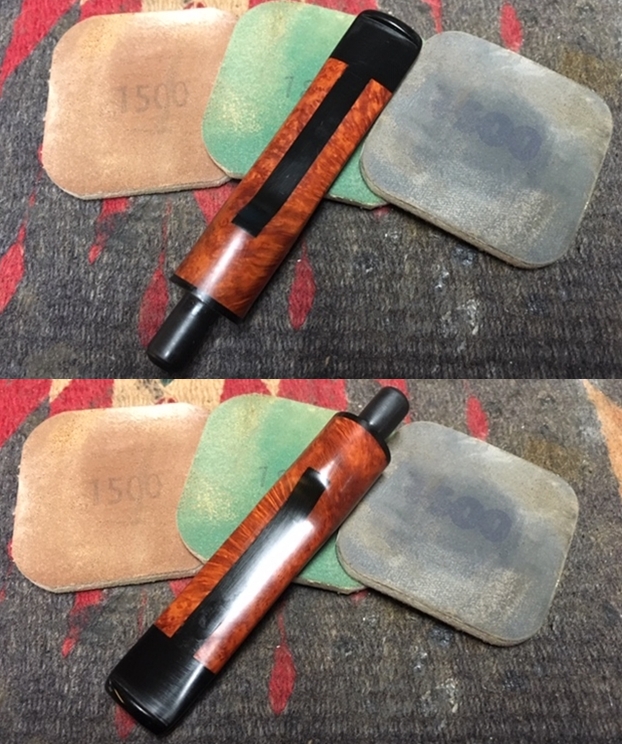
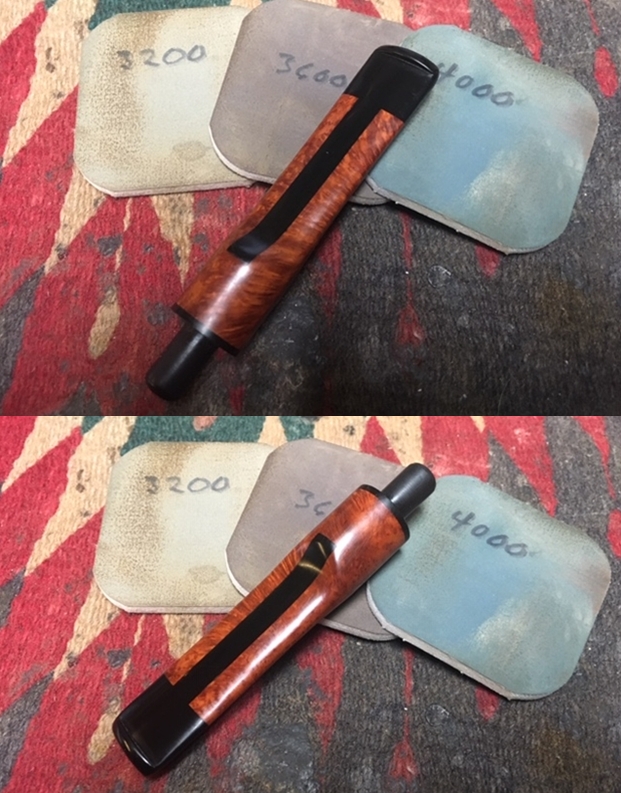
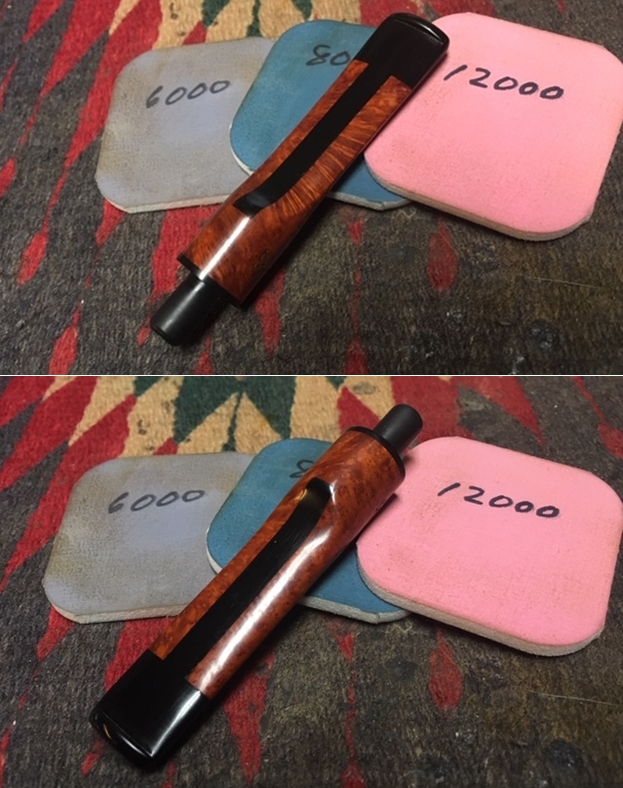 I put the bowl and stem back together. I polished the bowl and stem with Blue Diamond to polish out the scratches in the briar and acrylic. I gave the bowl and the stem multiple coats of carnauba wax. I buffed the pipe with a clean buffing pad to raise the shine. I hand buffed it with a microfiber cloth to deepen the shine. The pipe polished up pretty nicely. The contrast of colours between the briar bowl and the briar inserts on the stem really looked good with the polished black Lucite. The Aldo Velani Ultima 1 looked really good and was a great match to its bent brother. The pipe has a unique look that catches the eye. The finished pipe is shown in the photos below. The dimensions of the pipe are Length: 6 inches, Height: 2 ¼ inches, Outside diameter of the bowl: 1 1/2 inches, Chamber diameter: 7/8 of an inch. This one will soon be on the rebornpipes store if you are interested in adding it to your collection. Thanks for reading this while I worked on it. It was interesting and unusual piece to restore and I really enjoyed the work.
I put the bowl and stem back together. I polished the bowl and stem with Blue Diamond to polish out the scratches in the briar and acrylic. I gave the bowl and the stem multiple coats of carnauba wax. I buffed the pipe with a clean buffing pad to raise the shine. I hand buffed it with a microfiber cloth to deepen the shine. The pipe polished up pretty nicely. The contrast of colours between the briar bowl and the briar inserts on the stem really looked good with the polished black Lucite. The Aldo Velani Ultima 1 looked really good and was a great match to its bent brother. The pipe has a unique look that catches the eye. The finished pipe is shown in the photos below. The dimensions of the pipe are Length: 6 inches, Height: 2 ¼ inches, Outside diameter of the bowl: 1 1/2 inches, Chamber diameter: 7/8 of an inch. This one will soon be on the rebornpipes store if you are interested in adding it to your collection. Thanks for reading this while I worked on it. It was interesting and unusual piece to restore and I really enjoyed the work.